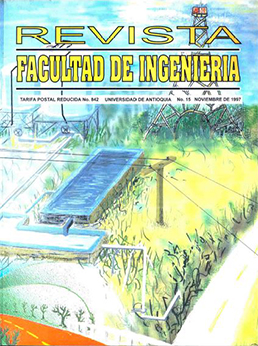Factores que determinan la emisión de contaminantes gaseosos y particulados por la combustión de combustibles fósiles
DOI:
https://doi.org/10.17533/udea.redin.325736Abstract
Se analiza el efecto de factores fisicoquímicos, cinéticos, estequiométricos y de las condiciones de mezcla sobre las emisiones de cinco principales clases de contaminantes producidos por los equipos de combustión.
Las emisiones de monóxido de carbono (CO) son gobernadas por la temperatura y la proporción aire a combustible.
La producción de óxidos de nitrógeno (NOx) está determinada por condiciones de operación (principalmente temperatura) y la composición del combustible.
Los óxidos de azufre (S0x) son altamente influenciados por la temperatura; en general es más rápida la formación de S02 que su oxidación a S03.
La temperatura y el grado de homogeneización de la mezcla son determinantes en la formación de compuestos orgánicos volátiles ("VOC").
La emisión de hollín y cenizas finas depende básicamente de la temperatura, relación aire-combustible y condiciones de homogeneización de la mezcla.
Downloads
References
AYEN, Richard J. and Tomo Oyonebayashi. Catalytic reduction of nitrogen dioxide by carbon monoxide. Atmospheric Environment. Vol. 1 Nº 3. May 1967. pp. 307-318. DOI: https://doi.org/10.1016/0004-6981(67)90011-X
BARTOK, William and Adel F. Sarofim. Fossil fuel combustion: a source book. Ed. John Wiley. EE. UU. 1991.
BURD, Vladimir, Squeezing clean energy Chemical Engineering. pp. 145-150. Vol. 99. March 1992.
CHO, Soung M. Properly aply selective catalytic reduction for NOx removal Chemical Engineering Progress. Vol. 90. Nº 1. January 1994. pp. 39-45.
GARG, Ashutosh. Specify better low-NOx burners for furnaces. Chemical Engineering Progress. Vol. 90. Nº 1. January 1994. pp. 46-49.
McINNES, Robert G. et. al. Wiping out air pollution. Chemical Engineering. pp. 106-135. Vol. 97. September 1990.
WOOD, Stephen C. Select the right NOx control technology Chemical Engineering Progress. Vol. 90 Nº 1. January 1994. pp. 32-38.
Downloads
Published
How to Cite
Issue
Section
License
Revista Facultad de Ingeniería, Universidad de Antioquia is licensed under the Creative Commons Attribution BY-NC-SA 4.0 license. https://creativecommons.org/licenses/by-nc-sa/4.0/deed.en
You are free to:
Share — copy and redistribute the material in any medium or format
Adapt — remix, transform, and build upon the material
Under the following terms:
Attribution — You must give appropriate credit, provide a link to the license, and indicate if changes were made. You may do so in any reasonable manner, but not in any way that suggests the licensor endorses you or your use.
NonCommercial — You may not use the material for commercial purposes.
ShareAlike — If you remix, transform, or build upon the material, you must distribute your contributions under the same license as the original.
The material published in the journal can be distributed, copied and exhibited by third parties if the respective credits are given to the journal. No commercial benefit can be obtained and derivative works must be under the same license terms as the original work.










 Twitter
Twitter